Professional Identity Essay: NMBA Standards and Nursing Practice
VerifiedAdded on 2022/11/30
|8
|2214
|275
Essay
AI Summary
This essay delves into the multifaceted aspects of professional identity within the nursing profession, using a case study of a registered nurse, Mary, working in aged care. The essay critically examines the components of a therapeutic relationship, such as trust, empathy, and self-awareness, and assesses whether Mary adheres to the NMBA standards in delivering person-centered and evidence-based care. It explores how Mary could cultivate a therapeutic relationship with her clients, highlighting the benefits for both patients and the nurse. Furthermore, the essay discusses the roles of peers and supervisors in upholding the NMBA Code of Conduct and Registered Nurse Standards for Practice, particularly in addressing concerns about unethical or unsafe nursing practices. The analysis emphasizes the importance of professional self-regulation, peer monitoring, and the supervisor's role in ensuring safe and quality patient care, ultimately advocating for the establishment and maintenance of therapeutic relationships to improve patient outcomes.
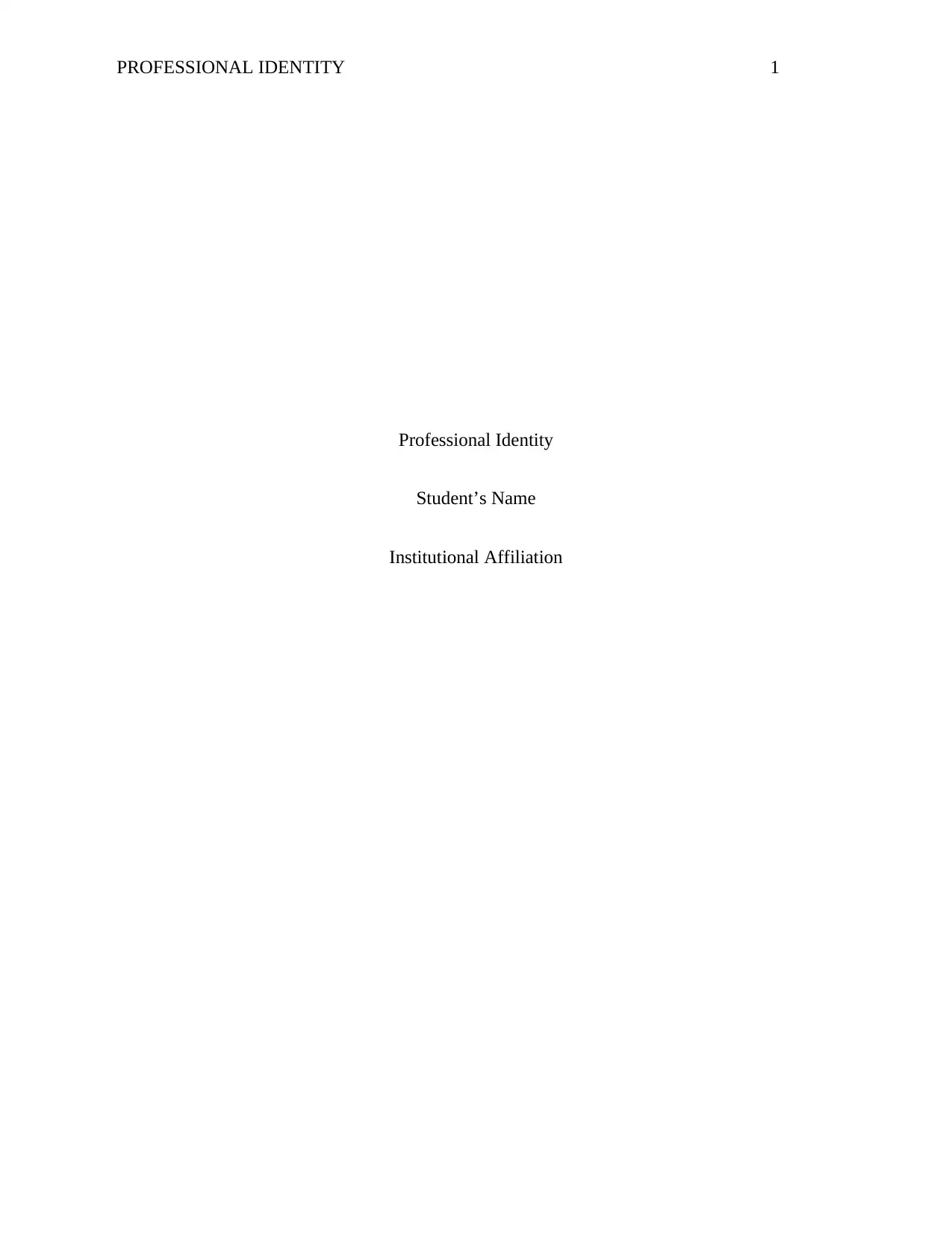
PROFESSIONAL IDENTITY 1
Professional Identity
Student’s Name
Institutional Affiliation
Professional Identity
Student’s Name
Institutional Affiliation
Paraphrase This Document
Need a fresh take? Get an instant paraphrase of this document with our AI Paraphraser
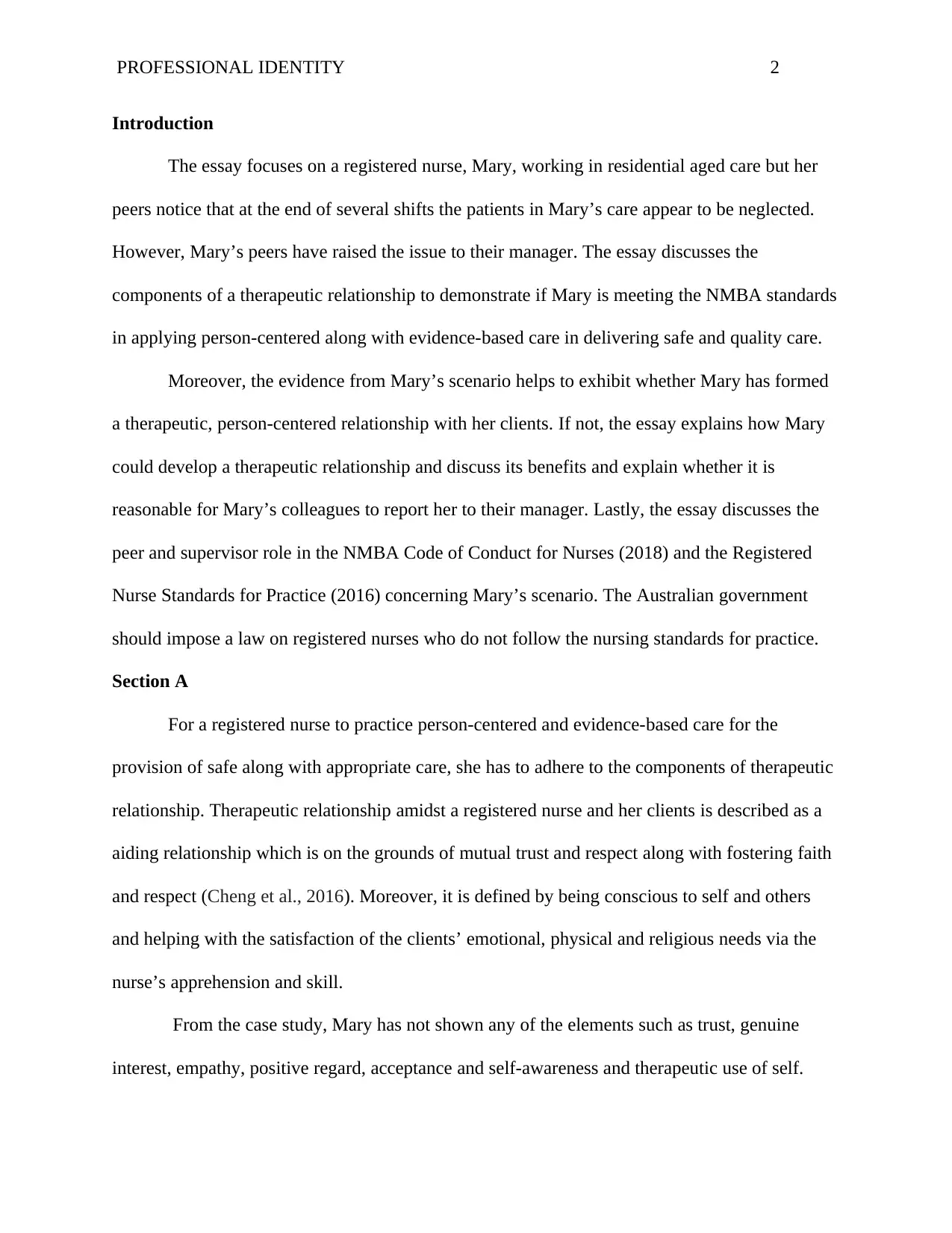
PROFESSIONAL IDENTITY 2
Introduction
The essay focuses on a registered nurse, Mary, working in residential aged care but her
peers notice that at the end of several shifts the patients in Mary’s care appear to be neglected.
However, Mary’s peers have raised the issue to their manager. The essay discusses the
components of a therapeutic relationship to demonstrate if Mary is meeting the NMBA standards
in applying person-centered along with evidence-based care in delivering safe and quality care.
Moreover, the evidence from Mary’s scenario helps to exhibit whether Mary has formed
a therapeutic, person-centered relationship with her clients. If not, the essay explains how Mary
could develop a therapeutic relationship and discuss its benefits and explain whether it is
reasonable for Mary’s colleagues to report her to their manager. Lastly, the essay discusses the
peer and supervisor role in the NMBA Code of Conduct for Nurses (2018) and the Registered
Nurse Standards for Practice (2016) concerning Mary’s scenario. The Australian government
should impose a law on registered nurses who do not follow the nursing standards for practice.
Section A
For a registered nurse to practice person-centered and evidence-based care for the
provision of safe along with appropriate care, she has to adhere to the components of therapeutic
relationship. Therapeutic relationship amidst a registered nurse and her clients is described as a
aiding relationship which is on the grounds of mutual trust and respect along with fostering faith
and respect (Cheng et al., 2016). Moreover, it is defined by being conscious to self and others
and helping with the satisfaction of the clients’ emotional, physical and religious needs via the
nurse’s apprehension and skill.
From the case study, Mary has not shown any of the elements such as trust, genuine
interest, empathy, positive regard, acceptance and self-awareness and therapeutic use of self.
Introduction
The essay focuses on a registered nurse, Mary, working in residential aged care but her
peers notice that at the end of several shifts the patients in Mary’s care appear to be neglected.
However, Mary’s peers have raised the issue to their manager. The essay discusses the
components of a therapeutic relationship to demonstrate if Mary is meeting the NMBA standards
in applying person-centered along with evidence-based care in delivering safe and quality care.
Moreover, the evidence from Mary’s scenario helps to exhibit whether Mary has formed
a therapeutic, person-centered relationship with her clients. If not, the essay explains how Mary
could develop a therapeutic relationship and discuss its benefits and explain whether it is
reasonable for Mary’s colleagues to report her to their manager. Lastly, the essay discusses the
peer and supervisor role in the NMBA Code of Conduct for Nurses (2018) and the Registered
Nurse Standards for Practice (2016) concerning Mary’s scenario. The Australian government
should impose a law on registered nurses who do not follow the nursing standards for practice.
Section A
For a registered nurse to practice person-centered and evidence-based care for the
provision of safe along with appropriate care, she has to adhere to the components of therapeutic
relationship. Therapeutic relationship amidst a registered nurse and her clients is described as a
aiding relationship which is on the grounds of mutual trust and respect along with fostering faith
and respect (Cheng et al., 2016). Moreover, it is defined by being conscious to self and others
and helping with the satisfaction of the clients’ emotional, physical and religious needs via the
nurse’s apprehension and skill.
From the case study, Mary has not shown any of the elements such as trust, genuine
interest, empathy, positive regard, acceptance and self-awareness and therapeutic use of self.
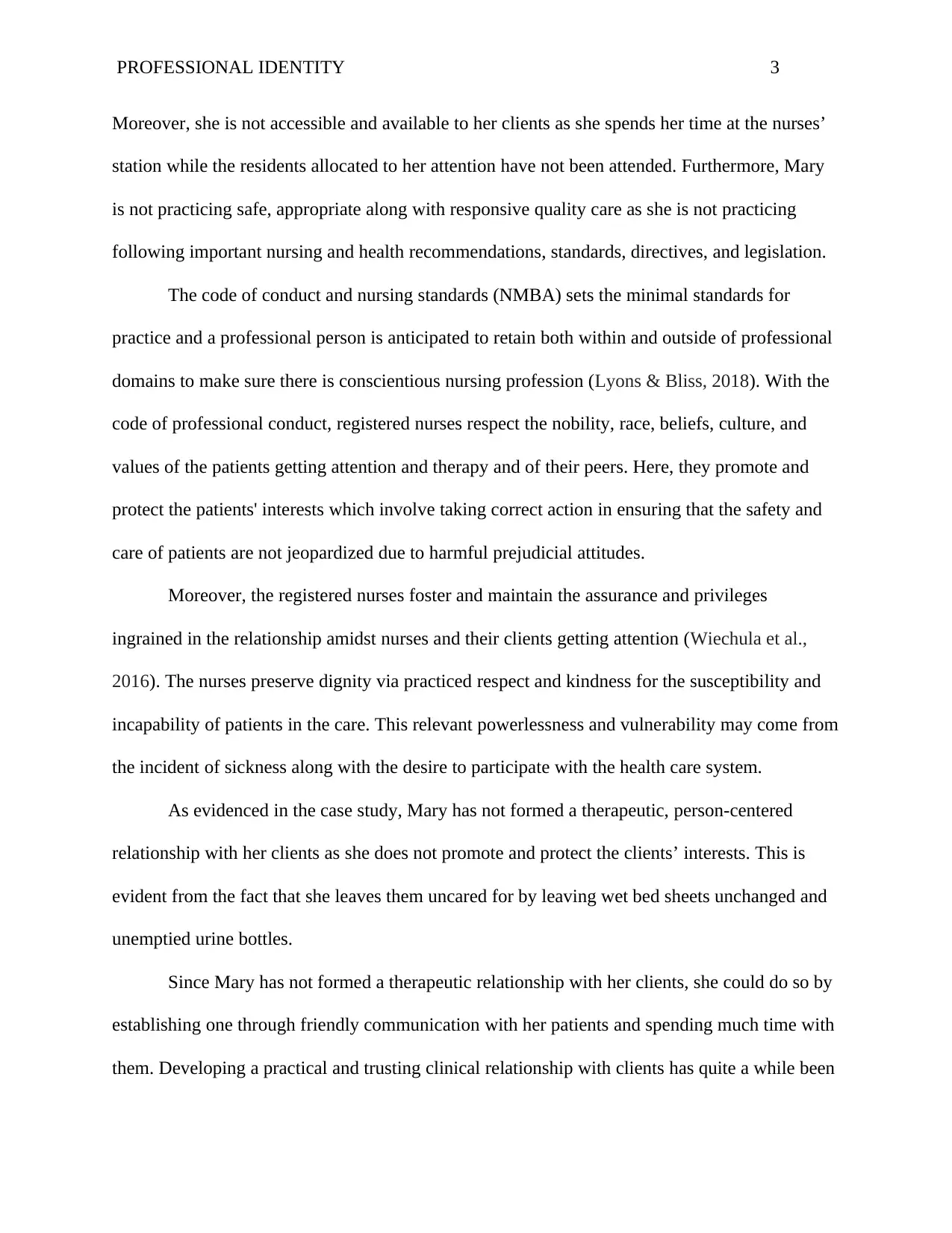
PROFESSIONAL IDENTITY 3
Moreover, she is not accessible and available to her clients as she spends her time at the nurses’
station while the residents allocated to her attention have not been attended. Furthermore, Mary
is not practicing safe, appropriate along with responsive quality care as she is not practicing
following important nursing and health recommendations, standards, directives, and legislation.
The code of conduct and nursing standards (NMBA) sets the minimal standards for
practice and a professional person is anticipated to retain both within and outside of professional
domains to make sure there is conscientious nursing profession (Lyons & Bliss, 2018). With the
code of professional conduct, registered nurses respect the nobility, race, beliefs, culture, and
values of the patients getting attention and therapy and of their peers. Here, they promote and
protect the patients' interests which involve taking correct action in ensuring that the safety and
care of patients are not jeopardized due to harmful prejudicial attitudes.
Moreover, the registered nurses foster and maintain the assurance and privileges
ingrained in the relationship amidst nurses and their clients getting attention (Wiechula et al.,
2016). The nurses preserve dignity via practiced respect and kindness for the susceptibility and
incapability of patients in the care. This relevant powerlessness and vulnerability may come from
the incident of sickness along with the desire to participate with the health care system.
As evidenced in the case study, Mary has not formed a therapeutic, person-centered
relationship with her clients as she does not promote and protect the clients’ interests. This is
evident from the fact that she leaves them uncared for by leaving wet bed sheets unchanged and
unemptied urine bottles.
Since Mary has not formed a therapeutic relationship with her clients, she could do so by
establishing one through friendly communication with her patients and spending much time with
them. Developing a practical and trusting clinical relationship with clients has quite a while been
Moreover, she is not accessible and available to her clients as she spends her time at the nurses’
station while the residents allocated to her attention have not been attended. Furthermore, Mary
is not practicing safe, appropriate along with responsive quality care as she is not practicing
following important nursing and health recommendations, standards, directives, and legislation.
The code of conduct and nursing standards (NMBA) sets the minimal standards for
practice and a professional person is anticipated to retain both within and outside of professional
domains to make sure there is conscientious nursing profession (Lyons & Bliss, 2018). With the
code of professional conduct, registered nurses respect the nobility, race, beliefs, culture, and
values of the patients getting attention and therapy and of their peers. Here, they promote and
protect the patients' interests which involve taking correct action in ensuring that the safety and
care of patients are not jeopardized due to harmful prejudicial attitudes.
Moreover, the registered nurses foster and maintain the assurance and privileges
ingrained in the relationship amidst nurses and their clients getting attention (Wiechula et al.,
2016). The nurses preserve dignity via practiced respect and kindness for the susceptibility and
incapability of patients in the care. This relevant powerlessness and vulnerability may come from
the incident of sickness along with the desire to participate with the health care system.
As evidenced in the case study, Mary has not formed a therapeutic, person-centered
relationship with her clients as she does not promote and protect the clients’ interests. This is
evident from the fact that she leaves them uncared for by leaving wet bed sheets unchanged and
unemptied urine bottles.
Since Mary has not formed a therapeutic relationship with her clients, she could do so by
establishing one through friendly communication with her patients and spending much time with
them. Developing a practical and trusting clinical relationship with clients has quite a while been
⊘ This is a preview!⊘
Do you want full access?
Subscribe today to unlock all pages.

Trusted by 1+ million students worldwide
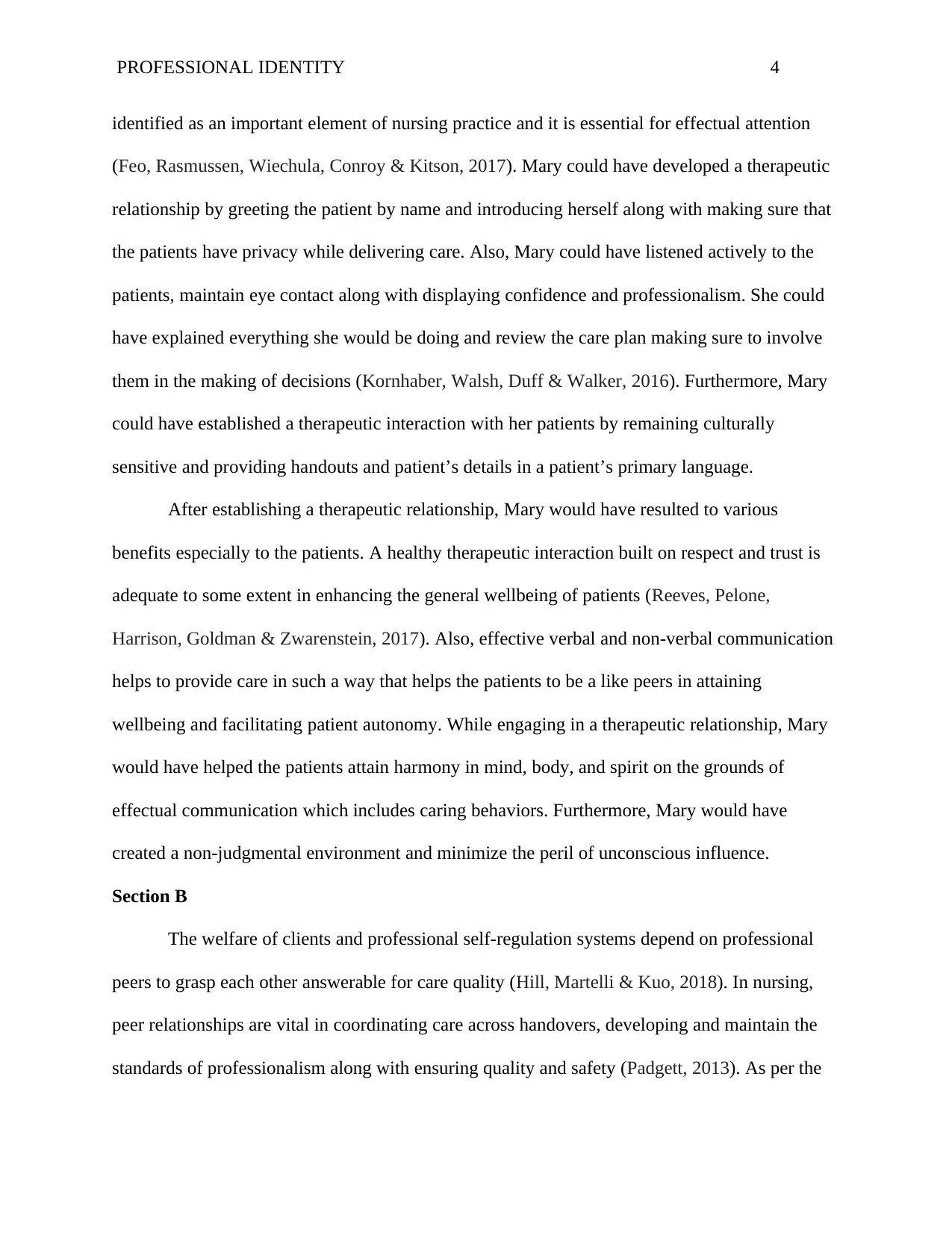
PROFESSIONAL IDENTITY 4
identified as an important element of nursing practice and it is essential for effectual attention
(Feo, Rasmussen, Wiechula, Conroy & Kitson, 2017). Mary could have developed a therapeutic
relationship by greeting the patient by name and introducing herself along with making sure that
the patients have privacy while delivering care. Also, Mary could have listened actively to the
patients, maintain eye contact along with displaying confidence and professionalism. She could
have explained everything she would be doing and review the care plan making sure to involve
them in the making of decisions (Kornhaber, Walsh, Duff & Walker, 2016). Furthermore, Mary
could have established a therapeutic interaction with her patients by remaining culturally
sensitive and providing handouts and patient’s details in a patient’s primary language.
After establishing a therapeutic relationship, Mary would have resulted to various
benefits especially to the patients. A healthy therapeutic interaction built on respect and trust is
adequate to some extent in enhancing the general wellbeing of patients (Reeves, Pelone,
Harrison, Goldman & Zwarenstein, 2017). Also, effective verbal and non-verbal communication
helps to provide care in such a way that helps the patients to be a like peers in attaining
wellbeing and facilitating patient autonomy. While engaging in a therapeutic relationship, Mary
would have helped the patients attain harmony in mind, body, and spirit on the grounds of
effectual communication which includes caring behaviors. Furthermore, Mary would have
created a non-judgmental environment and minimize the peril of unconscious influence.
Section B
The welfare of clients and professional self-regulation systems depend on professional
peers to grasp each other answerable for care quality (Hill, Martelli & Kuo, 2018). In nursing,
peer relationships are vital in coordinating care across handovers, developing and maintain the
standards of professionalism along with ensuring quality and safety (Padgett, 2013). As per the
identified as an important element of nursing practice and it is essential for effectual attention
(Feo, Rasmussen, Wiechula, Conroy & Kitson, 2017). Mary could have developed a therapeutic
relationship by greeting the patient by name and introducing herself along with making sure that
the patients have privacy while delivering care. Also, Mary could have listened actively to the
patients, maintain eye contact along with displaying confidence and professionalism. She could
have explained everything she would be doing and review the care plan making sure to involve
them in the making of decisions (Kornhaber, Walsh, Duff & Walker, 2016). Furthermore, Mary
could have established a therapeutic interaction with her patients by remaining culturally
sensitive and providing handouts and patient’s details in a patient’s primary language.
After establishing a therapeutic relationship, Mary would have resulted to various
benefits especially to the patients. A healthy therapeutic interaction built on respect and trust is
adequate to some extent in enhancing the general wellbeing of patients (Reeves, Pelone,
Harrison, Goldman & Zwarenstein, 2017). Also, effective verbal and non-verbal communication
helps to provide care in such a way that helps the patients to be a like peers in attaining
wellbeing and facilitating patient autonomy. While engaging in a therapeutic relationship, Mary
would have helped the patients attain harmony in mind, body, and spirit on the grounds of
effectual communication which includes caring behaviors. Furthermore, Mary would have
created a non-judgmental environment and minimize the peril of unconscious influence.
Section B
The welfare of clients and professional self-regulation systems depend on professional
peers to grasp each other answerable for care quality (Hill, Martelli & Kuo, 2018). In nursing,
peer relationships are vital in coordinating care across handovers, developing and maintain the
standards of professionalism along with ensuring quality and safety (Padgett, 2013). As per the
Paraphrase This Document
Need a fresh take? Get an instant paraphrase of this document with our AI Paraphraser
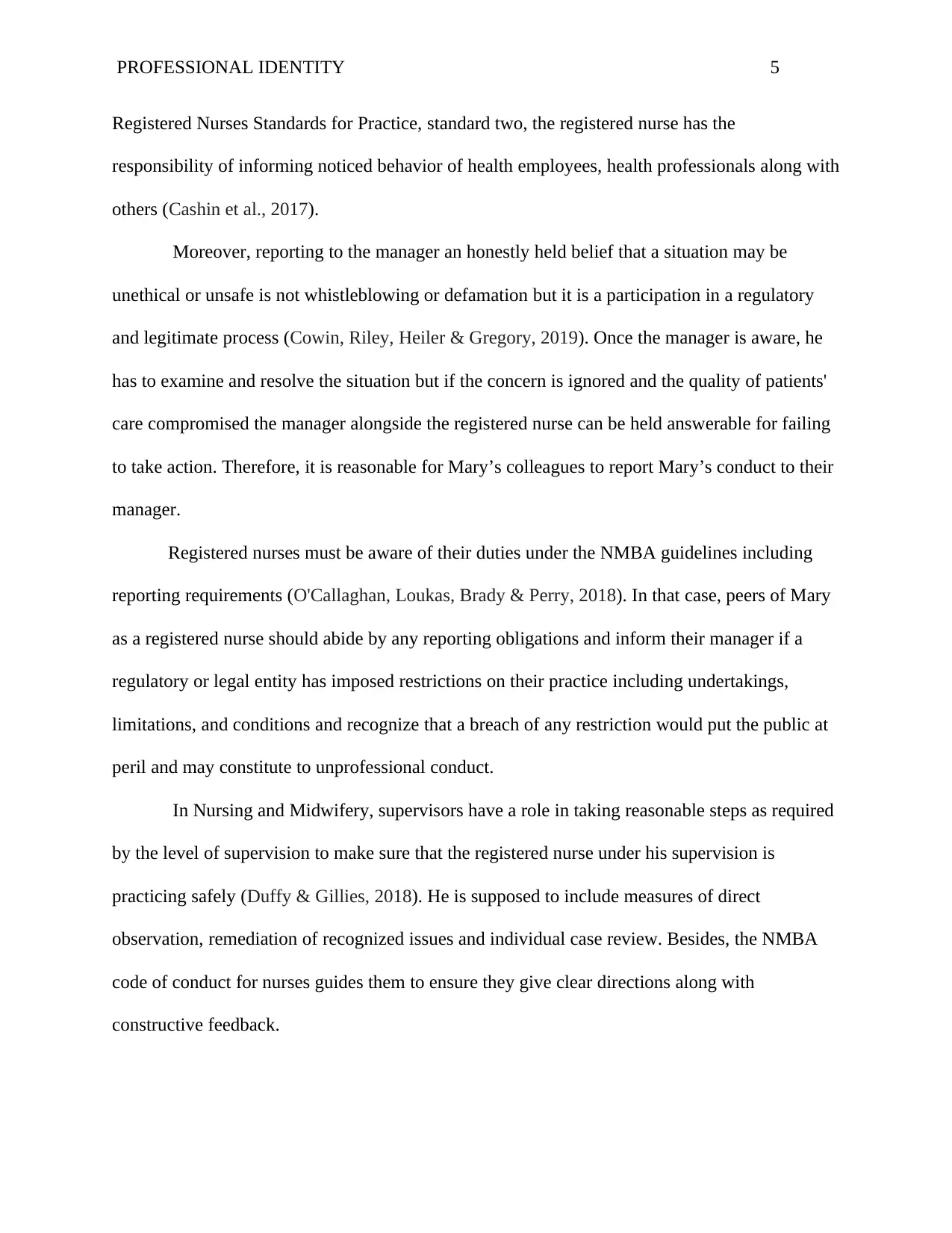
PROFESSIONAL IDENTITY 5
Registered Nurses Standards for Practice, standard two, the registered nurse has the
responsibility of informing noticed behavior of health employees, health professionals along with
others (Cashin et al., 2017).
Moreover, reporting to the manager an honestly held belief that a situation may be
unethical or unsafe is not whistleblowing or defamation but it is a participation in a regulatory
and legitimate process (Cowin, Riley, Heiler & Gregory, 2019). Once the manager is aware, he
has to examine and resolve the situation but if the concern is ignored and the quality of patients'
care compromised the manager alongside the registered nurse can be held answerable for failing
to take action. Therefore, it is reasonable for Mary’s colleagues to report Mary’s conduct to their
manager.
Registered nurses must be aware of their duties under the NMBA guidelines including
reporting requirements (O'Callaghan, Loukas, Brady & Perry, 2018). In that case, peers of Mary
as a registered nurse should abide by any reporting obligations and inform their manager if a
regulatory or legal entity has imposed restrictions on their practice including undertakings,
limitations, and conditions and recognize that a breach of any restriction would put the public at
peril and may constitute to unprofessional conduct.
In Nursing and Midwifery, supervisors have a role in taking reasonable steps as required
by the level of supervision to make sure that the registered nurse under his supervision is
practicing safely (Duffy & Gillies, 2018). He is supposed to include measures of direct
observation, remediation of recognized issues and individual case review. Besides, the NMBA
code of conduct for nurses guides them to ensure they give clear directions along with
constructive feedback.
Registered Nurses Standards for Practice, standard two, the registered nurse has the
responsibility of informing noticed behavior of health employees, health professionals along with
others (Cashin et al., 2017).
Moreover, reporting to the manager an honestly held belief that a situation may be
unethical or unsafe is not whistleblowing or defamation but it is a participation in a regulatory
and legitimate process (Cowin, Riley, Heiler & Gregory, 2019). Once the manager is aware, he
has to examine and resolve the situation but if the concern is ignored and the quality of patients'
care compromised the manager alongside the registered nurse can be held answerable for failing
to take action. Therefore, it is reasonable for Mary’s colleagues to report Mary’s conduct to their
manager.
Registered nurses must be aware of their duties under the NMBA guidelines including
reporting requirements (O'Callaghan, Loukas, Brady & Perry, 2018). In that case, peers of Mary
as a registered nurse should abide by any reporting obligations and inform their manager if a
regulatory or legal entity has imposed restrictions on their practice including undertakings,
limitations, and conditions and recognize that a breach of any restriction would put the public at
peril and may constitute to unprofessional conduct.
In Nursing and Midwifery, supervisors have a role in taking reasonable steps as required
by the level of supervision to make sure that the registered nurse under his supervision is
practicing safely (Duffy & Gillies, 2018). He is supposed to include measures of direct
observation, remediation of recognized issues and individual case review. Besides, the NMBA
code of conduct for nurses guides them to ensure they give clear directions along with
constructive feedback.
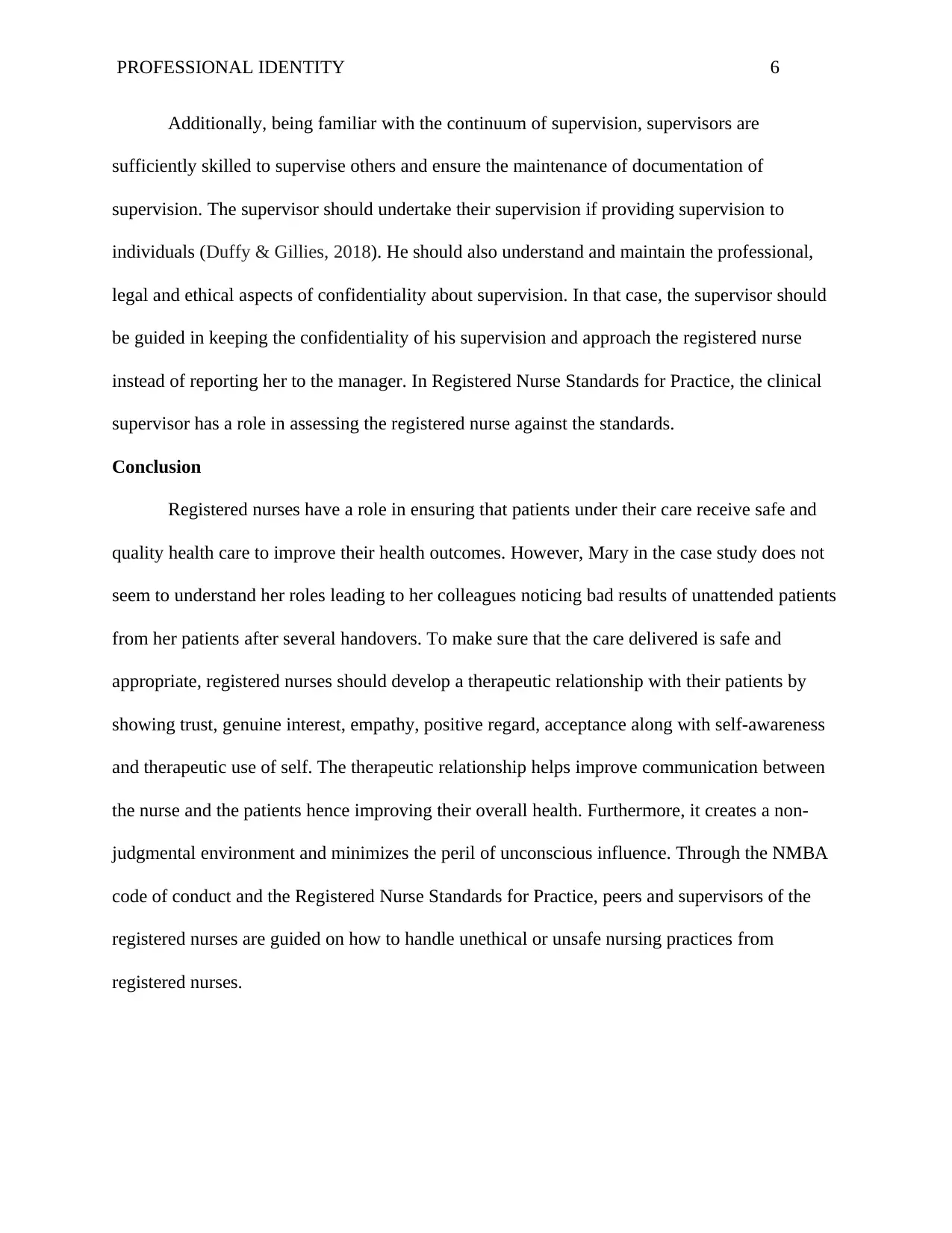
PROFESSIONAL IDENTITY 6
Additionally, being familiar with the continuum of supervision, supervisors are
sufficiently skilled to supervise others and ensure the maintenance of documentation of
supervision. The supervisor should undertake their supervision if providing supervision to
individuals (Duffy & Gillies, 2018). He should also understand and maintain the professional,
legal and ethical aspects of confidentiality about supervision. In that case, the supervisor should
be guided in keeping the confidentiality of his supervision and approach the registered nurse
instead of reporting her to the manager. In Registered Nurse Standards for Practice, the clinical
supervisor has a role in assessing the registered nurse against the standards.
Conclusion
Registered nurses have a role in ensuring that patients under their care receive safe and
quality health care to improve their health outcomes. However, Mary in the case study does not
seem to understand her roles leading to her colleagues noticing bad results of unattended patients
from her patients after several handovers. To make sure that the care delivered is safe and
appropriate, registered nurses should develop a therapeutic relationship with their patients by
showing trust, genuine interest, empathy, positive regard, acceptance along with self-awareness
and therapeutic use of self. The therapeutic relationship helps improve communication between
the nurse and the patients hence improving their overall health. Furthermore, it creates a non-
judgmental environment and minimizes the peril of unconscious influence. Through the NMBA
code of conduct and the Registered Nurse Standards for Practice, peers and supervisors of the
registered nurses are guided on how to handle unethical or unsafe nursing practices from
registered nurses.
Additionally, being familiar with the continuum of supervision, supervisors are
sufficiently skilled to supervise others and ensure the maintenance of documentation of
supervision. The supervisor should undertake their supervision if providing supervision to
individuals (Duffy & Gillies, 2018). He should also understand and maintain the professional,
legal and ethical aspects of confidentiality about supervision. In that case, the supervisor should
be guided in keeping the confidentiality of his supervision and approach the registered nurse
instead of reporting her to the manager. In Registered Nurse Standards for Practice, the clinical
supervisor has a role in assessing the registered nurse against the standards.
Conclusion
Registered nurses have a role in ensuring that patients under their care receive safe and
quality health care to improve their health outcomes. However, Mary in the case study does not
seem to understand her roles leading to her colleagues noticing bad results of unattended patients
from her patients after several handovers. To make sure that the care delivered is safe and
appropriate, registered nurses should develop a therapeutic relationship with their patients by
showing trust, genuine interest, empathy, positive regard, acceptance along with self-awareness
and therapeutic use of self. The therapeutic relationship helps improve communication between
the nurse and the patients hence improving their overall health. Furthermore, it creates a non-
judgmental environment and minimizes the peril of unconscious influence. Through the NMBA
code of conduct and the Registered Nurse Standards for Practice, peers and supervisors of the
registered nurses are guided on how to handle unethical or unsafe nursing practices from
registered nurses.
⊘ This is a preview!⊘
Do you want full access?
Subscribe today to unlock all pages.

Trusted by 1+ million students worldwide
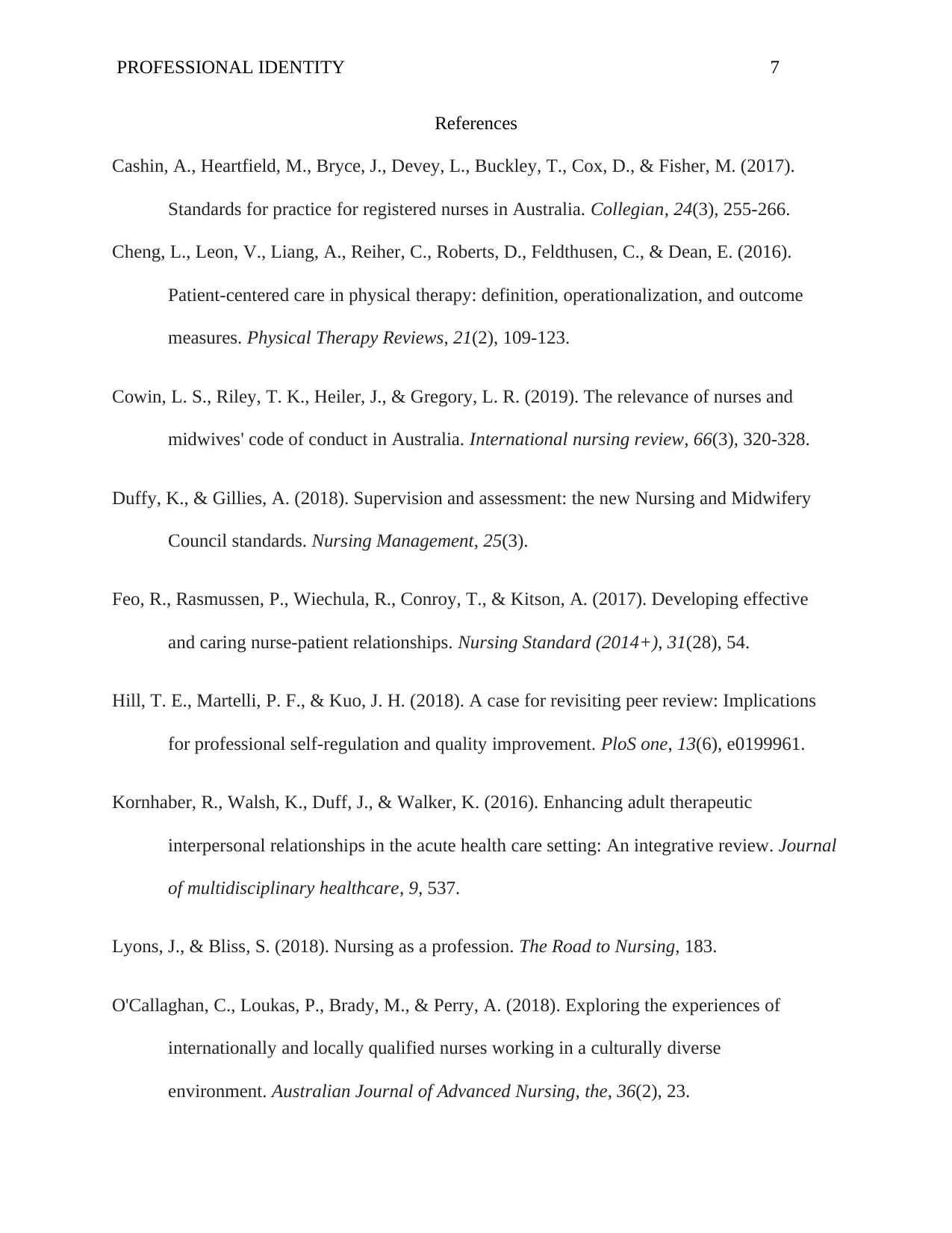
PROFESSIONAL IDENTITY 7
References
Cashin, A., Heartfield, M., Bryce, J., Devey, L., Buckley, T., Cox, D., & Fisher, M. (2017).
Standards for practice for registered nurses in Australia. Collegian, 24(3), 255-266.
Cheng, L., Leon, V., Liang, A., Reiher, C., Roberts, D., Feldthusen, C., & Dean, E. (2016).
Patient-centered care in physical therapy: definition, operationalization, and outcome
measures. Physical Therapy Reviews, 21(2), 109-123.
Cowin, L. S., Riley, T. K., Heiler, J., & Gregory, L. R. (2019). The relevance of nurses and
midwives' code of conduct in Australia. International nursing review, 66(3), 320-328.
Duffy, K., & Gillies, A. (2018). Supervision and assessment: the new Nursing and Midwifery
Council standards. Nursing Management, 25(3).
Feo, R., Rasmussen, P., Wiechula, R., Conroy, T., & Kitson, A. (2017). Developing effective
and caring nurse-patient relationships. Nursing Standard (2014+), 31(28), 54.
Hill, T. E., Martelli, P. F., & Kuo, J. H. (2018). A case for revisiting peer review: Implications
for professional self-regulation and quality improvement. PloS one, 13(6), e0199961.
Kornhaber, R., Walsh, K., Duff, J., & Walker, K. (2016). Enhancing adult therapeutic
interpersonal relationships in the acute health care setting: An integrative review. Journal
of multidisciplinary healthcare, 9, 537.
Lyons, J., & Bliss, S. (2018). Nursing as a profession. The Road to Nursing, 183.
O'Callaghan, C., Loukas, P., Brady, M., & Perry, A. (2018). Exploring the experiences of
internationally and locally qualified nurses working in a culturally diverse
environment. Australian Journal of Advanced Nursing, the, 36(2), 23.
References
Cashin, A., Heartfield, M., Bryce, J., Devey, L., Buckley, T., Cox, D., & Fisher, M. (2017).
Standards for practice for registered nurses in Australia. Collegian, 24(3), 255-266.
Cheng, L., Leon, V., Liang, A., Reiher, C., Roberts, D., Feldthusen, C., & Dean, E. (2016).
Patient-centered care in physical therapy: definition, operationalization, and outcome
measures. Physical Therapy Reviews, 21(2), 109-123.
Cowin, L. S., Riley, T. K., Heiler, J., & Gregory, L. R. (2019). The relevance of nurses and
midwives' code of conduct in Australia. International nursing review, 66(3), 320-328.
Duffy, K., & Gillies, A. (2018). Supervision and assessment: the new Nursing and Midwifery
Council standards. Nursing Management, 25(3).
Feo, R., Rasmussen, P., Wiechula, R., Conroy, T., & Kitson, A. (2017). Developing effective
and caring nurse-patient relationships. Nursing Standard (2014+), 31(28), 54.
Hill, T. E., Martelli, P. F., & Kuo, J. H. (2018). A case for revisiting peer review: Implications
for professional self-regulation and quality improvement. PloS one, 13(6), e0199961.
Kornhaber, R., Walsh, K., Duff, J., & Walker, K. (2016). Enhancing adult therapeutic
interpersonal relationships in the acute health care setting: An integrative review. Journal
of multidisciplinary healthcare, 9, 537.
Lyons, J., & Bliss, S. (2018). Nursing as a profession. The Road to Nursing, 183.
O'Callaghan, C., Loukas, P., Brady, M., & Perry, A. (2018). Exploring the experiences of
internationally and locally qualified nurses working in a culturally diverse
environment. Australian Journal of Advanced Nursing, the, 36(2), 23.
Paraphrase This Document
Need a fresh take? Get an instant paraphrase of this document with our AI Paraphraser
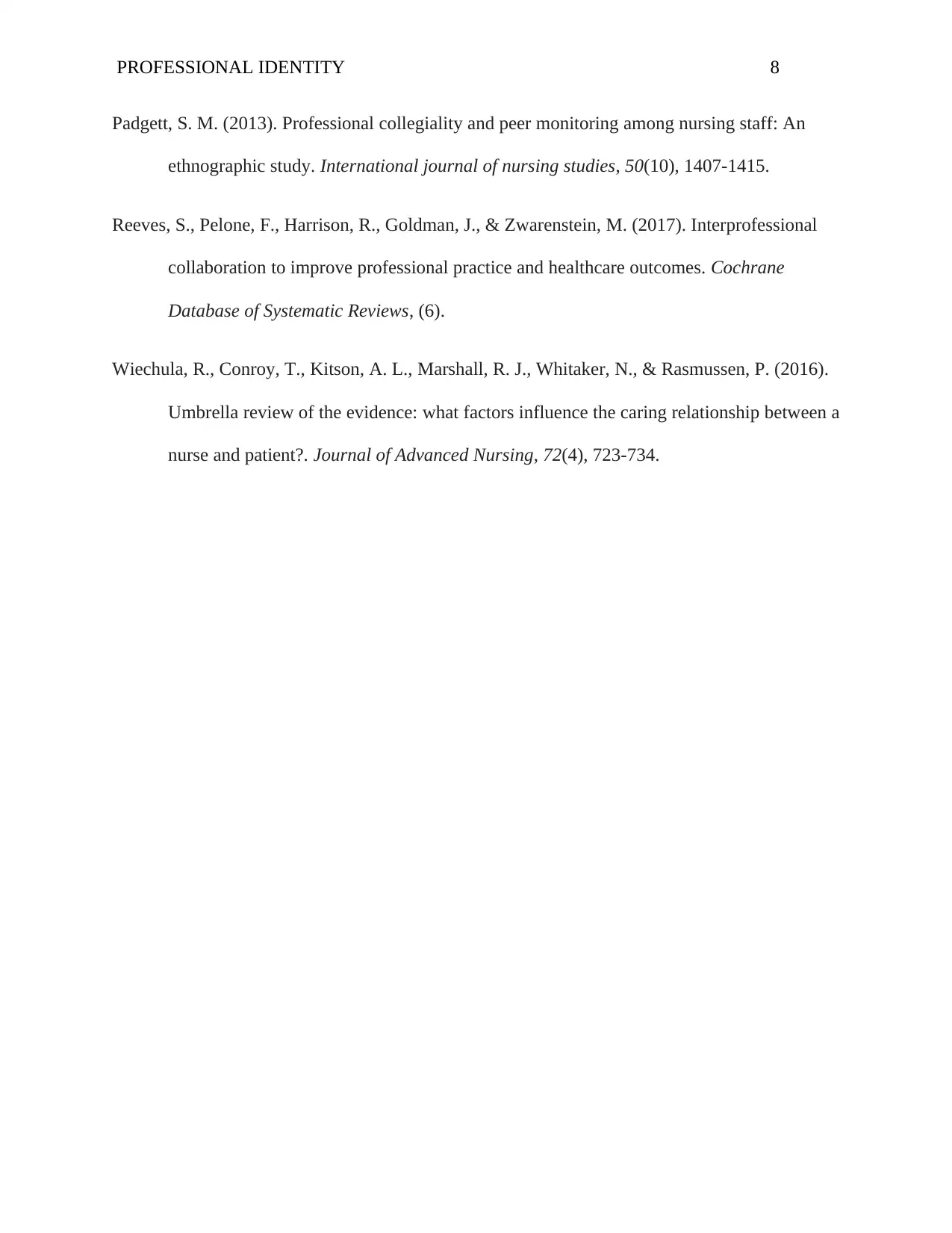
PROFESSIONAL IDENTITY 8
Padgett, S. M. (2013). Professional collegiality and peer monitoring among nursing staff: An
ethnographic study. International journal of nursing studies, 50(10), 1407-1415.
Reeves, S., Pelone, F., Harrison, R., Goldman, J., & Zwarenstein, M. (2017). Interprofessional
collaboration to improve professional practice and healthcare outcomes. Cochrane
Database of Systematic Reviews, (6).
Wiechula, R., Conroy, T., Kitson, A. L., Marshall, R. J., Whitaker, N., & Rasmussen, P. (2016).
Umbrella review of the evidence: what factors influence the caring relationship between a
nurse and patient?. Journal of Advanced Nursing, 72(4), 723-734.
Padgett, S. M. (2013). Professional collegiality and peer monitoring among nursing staff: An
ethnographic study. International journal of nursing studies, 50(10), 1407-1415.
Reeves, S., Pelone, F., Harrison, R., Goldman, J., & Zwarenstein, M. (2017). Interprofessional
collaboration to improve professional practice and healthcare outcomes. Cochrane
Database of Systematic Reviews, (6).
Wiechula, R., Conroy, T., Kitson, A. L., Marshall, R. J., Whitaker, N., & Rasmussen, P. (2016).
Umbrella review of the evidence: what factors influence the caring relationship between a
nurse and patient?. Journal of Advanced Nursing, 72(4), 723-734.
1 out of 8
Related Documents
Your All-in-One AI-Powered Toolkit for Academic Success.
+13062052269
info@desklib.com
Available 24*7 on WhatsApp / Email
![[object Object]](/_next/static/media/star-bottom.7253800d.svg)
Unlock your academic potential
Copyright © 2020–2025 A2Z Services. All Rights Reserved. Developed and managed by ZUCOL.





